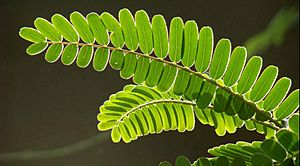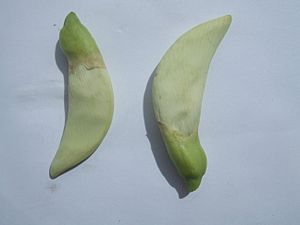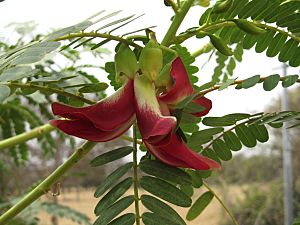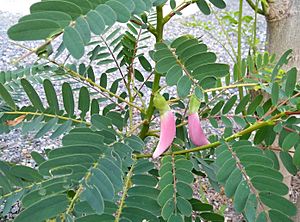Vegetable hummingbird facts for kids
Quick facts for kids Vegetable hummingbird |
|
|---|---|
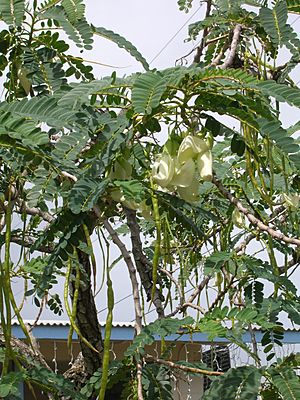 |
|
| Scientific classification | |
| Kingdom: | |
| (unranked): | |
| (unranked): | |
| (unranked): | |
| Order: | |
| Family: | |
| Genus: |
Sesbania
|
| Species: |
S. grandiflora
|
| Binomial name | |
| Sesbania grandiflora (L.) Poiret
|
|
| Synonyms | |
|
|
Sesbania grandiflora is a small tree. People often call it the vegetable hummingbird, West Indian pea, agati, or katurai. It belongs to the Sesbania group in the legume family. This tree is special because its flowers and leaves are edible. Many people in Southeast Asia and South Asia enjoy eating them.
Contents
What Does the Agati Tree Look Like?
This tree grows very quickly. It is a small tree, usually about 3 to 8 meters (10 to 26 feet) tall. Its wood is quite soft.
Leaves and Flowers
The leaves are long, about 15 to 30 centimeters (6 to 12 inches). Each leaf has many small leaflets, often 10 to 20 pairs or more. The flowers can be white, red, or pink. They are shaped like oblong bells and are about 1.5 to 10 centimeters (0.6 to 4 inches) long. These flowers grow in loose clusters called racemes.
Fruits and Seeds
The fruits of the agati tree look like long, flat, green beans. They can be straight or slightly curved. These pods are about 30 to 45 centimeters (12 to 18 inches) long. Inside, each pod holds about 30 seeds. Each seed is small, around 8 millimeters (0.3 inches) in size.
Growing Conditions
The agati tree loves lots of sunshine. It grows best in hot, humid places with good soil. This tree is very sensitive to cold weather and frost.
| Nutritional value per 100 g (3.5 oz) | |
|---|---|
| Energy | 113 kJ (27 kcal) |
|
6.73 g
|
|
|
0.04 g
|
|
|
Protein
|
1.28 g
|
| Vitamins | Quantity
%DV†
|
| Thiamine (B1) |
7%
0.083 mg |
| Riboflavin (B2) |
7%
0.081 mg |
| Niacin (B3) |
3%
0.43 mg |
| Folate (B9) |
26%
102 μg |
| Vitamin C |
88%
73 mg |
| Minerals | Quantity
%DV†
|
| Calcium |
2%
19 mg |
| Iron |
6%
0.84 mg |
| Magnesium |
3%
12 mg |
| Phosphorus |
4%
30 mg |
| Potassium |
6%
184 mg |
|
Link to USDA Database entry
|
|
| †Percentages estimated using US recommendations for adults. | |
Where Does the Agati Tree Grow?
The agati tree originally comes from Southeast Asia. You can find it in countries like Malaysia, the Philippines, and Brunei. It also grows in Northern Australia. People now grow it in many parts of India and Sri Lanka too.
Traditional Uses of Agati
People have used parts of the agati tree for a long time. It has many traditional uses, especially in cooking and for health.
Agati in Traditional Medicine
In some cultures, people use parts of the agati tree in traditional medicine. For example, extracts from the leaves have been studied for their health benefits.
How People Use Agati in Cooking
The flowers of S. grandiflora are a popular vegetable. They are eaten in many countries in South Asia and Southeast Asia.
Agati Flowers as Food
- In Laos, Thailand, Java and Lombok in Indonesia, and Vietnam, people eat the flowers.
- In the Maldives, they call it Feeru Muran'ga.
- In Sri Lanka, it's known as Katuru murunga.
- In the Ilocos Region of the Philippines, the flowers are also a common food.
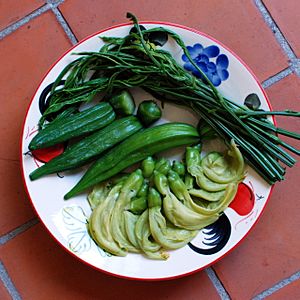
Agati in Different Cuisines
- In Khmer language (Cambodia), the flowers are called ផ្កាអង្គាដី (angkea dei). Young leaves and flowers are cooked in curries, like Samlor mchou angkea dei. They are also used in salad sauces.
- In the Thai language, the flowers are called ดอกแค (dok khae). They are used in curries such as kaeng som and kaeng khae. People also eat them raw or blanched with a dipping sauce called nam phrik.
Other Edible Parts
The young pods of the agati tree are also eaten. In Sri Lanka, the leaves are sometimes added to a white curry called sudhu hodhi. This curry is a thin sauce made with coconut.
In India, this plant has different names like agati (Tamil), agastya (Kannada), and అవిసె (Telugu). Both the leaves and the flowers are used in cooking there. In West Bengal, India, and Bangladesh, it's called Bok phool (বকফুল). People often fry the flowers with a paste made from gram flour before eating them.
See also
 In Spanish: Agati de la India para niños
In Spanish: Agati de la India para niños


